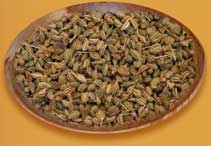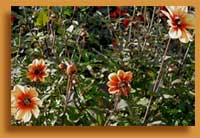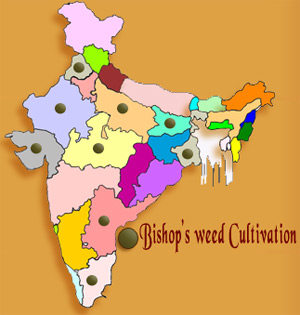BISHOP'S WEED
Introduction
Bishop's Weed which is also known as Goutweed, is one of the most dangerous plants that a gardener can grow in his backyard. A bishop's weed is a vertical, glabrous or minutely juvenile, pronged annual plant. The stems are straight, the leaves are fairly isolated, 2-3-pinnately separated and the segments are linear. The flowers come about in terminal or seemingly-sideways pedunculate, compound umbels, white and little, the fruits are ovoid, muricate, sweet-smelling cremocarps, grayish brown in color, the mericarps, which are the elements of the fruit, are squashed, with discrete ridges and tubular surface and is one- seeded. Common Names
Trachyspermum ammi (L.) Sprague is the scientific botanical name of the plant. In common languages of India as in Hindi it is called as Ajwain; in Bengali it it is called as Jowan or Joan; in Gujarati it is called as Yavan; in Kannada it is called as Oma; in Kashmiri it is called as Jawind; in Malayalam it is called as Omum; in Marathi it is called as Onva; in Oriya it is called as Juani; in Punjabi it is called as Ajamoda, Avanika; in Sanskrit it is called as Ajamoda, Avanika; in Tamil it is called as Omum; in Telugu it is called as Vamu; in Urdu it is called as Ajowain.
History

The juvenile leaves are characteristically harvested in the spring season and is eaten as salads or, when picked later in the same season, it is cooked like with our favorite green vegetables. The blooms and the small fruits can also be eaten because all mentioned parts are packed with a healthy grouping of vitamins, minerals and protein.The plant is mainly rich in potassium, calcium, zinc, and vitamin A and vitamin C. Bishop's weed has a preference of wet and shady places. It has a tendency to broaden through its extensive rhizomes, hence it is typically found in colonies of different sizes. One of its familiar German name is Geißfuß or goat's foot, which seems to precisely describe the exceptional shape of the leaves. Ajwain instigated in the Middle East, maybe in Egypt and the Indian Subcontinent, but also in Egypt, Iran and Afghanistan. In India, the chief Ajwain producing states are Rajasthan and Gujarat, where Rajasthan harvests about 90% of India's total manufacture.
Chemistry of the plant

The seed of the plant also restrains 6-O-ß-glucopyranosyloxythymol, a glucoside. Some other chemical research hs reported 69% carvacrol in T. ammi , and a succumb of 25% oleoresin containing 12% volatile oil constituting thymol, γ-terpinene, para-cymene, and a- and ß-pinene. The primary oil constitutes of carvone to about 46%, limonene to about 38%, and dillapiole to about 9%. The essential oil attained by steam distillation process of the fruits of the copticum yielded thymol of 61%, para-cymene of 15%, and γ-terpinene of 12%.
Uses
The Bishop's weed has a wide range of medicinal uses that may be as follows:- As a digestive aid by chewing it in raw form or with a small amount of sugar to make it more edible in its raw form.
- As a cure for diarrhea, dysentery and indigestion. The weed is boiled in a cup of water and it is left to boil continuously till the water in the pan is condensed to half its original volume. The water obtained in this process is taken as a cure for diarrhea, dysentery and indigestion.
- The seed is considered as a refreshment and is helpful in working against spasmodic disorders. The oil of the weed is more or less colorless to brownish liquid with a very distinctive odour and has a sharp hot taste. If the oil is permitted to remain uninterrupted, a fraction of the thymol may part from the crystals, which is sold in Indian marketplaces under the name of aiwain ka phul or sat aiwain. It is much treasured in medicine as it has nearly all the characteristics ascribed to the Bishop's weed seeds.
- Bishop's weed is a successful common cold medicine. It has an extraordinary influence to open up blocked and congested nasal passages. A tablespoon of seeds trampled and tied up in a cloth pack can be used for breathing. A comparable bundle positioned near the pillow, while sleeping, also relieves nasal blocking. For babies and small children, a little pouch can be pinned to their clothes under the cheek when they are sleeping. In case of adults, a teaspoon of the seed can be put in steaming water and the vapours can beinhaled.
- The seeds, pooled with the essential part of tamarind seeds is a successful aphrodisiac. These should be fried in an equivalent amount of pure ghee, crushed and preserved in sealed containers. A teaspoon of this residue, mixed with a tablespoon of honey, eaten daily with milk before retiring, makes an outstanding aphrodisiac. It enhances virility and cures early ejaculation.
- The grayish brown fruits or seeds are used as a seasoning, in flavoring several foods, as anti-oxidants, preservatives and in medication.
Bishop's Weed Cultivation in India

